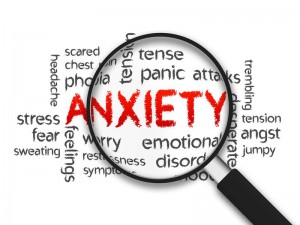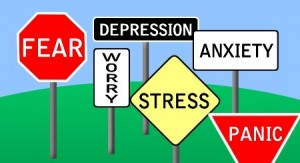Crash Course to Anxiety Disorders
October 19, 2015
What is anxiety?
Anxiety is a mental state that is characterized by persistent and chronic feelings of threat or worry. It usually occurs when some aspect of your life feels uncontrollable or temporary feelings of stress are not relieved. Anxiety symptoms can be alleviated quickly if taken care of, or they can manifest into an anxiety disorder. An anxiety disorder occurs when symptoms of anxiety affect a person’s ability to function in daily life. You can determine if you have an anxiety disorder by visiting your doctor and having them evaluate your medical and mental health history, performing a physical exam, and usually a drug test because some medications and drugs can have side effects that are similar to anxiety symptoms.

Being aware of anxiety disorders is important because, as college students, we are in a time of our lives that is high-risk for developing an anxiety disorder. According to our textbook, Access to Health, 40 million Americans over the age of 18 suffer from some type of anxiety disorder. This is shown even more by the statistic that 9.4% of undergraduates deal with anxiety. That may not seem like much, but anxiety is something that no one should have to deal with, especially college students with so much on our plates. The presence of an anxiety disorder is more often than not accompanied by depression as well. Depression can lead to a whole other set of problems outside those associated with anxiety disorders. Both anxiety and depression lead to self-harm behaviors, which 17-38% of college students with anxiety disorders do.
Types of Anxiety Disorders
Generalized Anxiety Disorder
This disorder is characterized by chronic symptoms of anxiety with no particular trigger that the person can pinpoint. To be diagnosed with GAD, you must have at least three symptoms for more days than not over the period of six months. Symptoms of anxiety include irritability, inability to concentrate, muscle tension, restlessness, being easily fatigued, and unrealistic and exaggerated worry about every day events. There are no concrete causes of any anxiety disorder, but GAD seems to run in families.
Panic disorders are characterized by the occurrence of panic attacks. Panic attacks are short-lived, intense physical reactions to anxiety. They can last up to a half hour, depending on the severity. These attacks involve physical symptom such as an increased rate of breathing, hot flashes, stomach cramps, chest pain, chills, having trouble swallowing, and a feeling of being doomed or sense of death. Some professionals think this could be an over reactive fight or flight response. They leave the person feeling drained and very tired. Panic disorders can make people very anxious about going out in public places because of the occurrence of panic attacks, which becomes destructive to their life. Panic disorders increase the likelihood of developing agoraphobia, which is the fear of being in any place or situation that is hard to escape from in the event of a panic attack. Panic attacks can be triggered by a source of anxiety that the person deals with, or could happen for no reason. According to Access to Health, 6 million Americans over the age of 18 suffer from panic disorders. They usually show up in early adulthood and are more common in women than in men.

Phobic Disorders
Having a phobia means that you have an irrational and persistent fear of something specific, like an object, activity, or situation. With this irrational fear comes the intense need to avoid that particular trigger of fear/anxiety. Common phobias include arachnophobia, fear of spiders, and social phobia, fear of being humiliated or embarrassed in social situations. Social phobia tends to lead to people avoiding social situations altogether.
Obsessive Compulsive Disorder
Obsessive Compulsive Disorder is characterized by repetitive behaviors such as rituals, and recurrent, unwelcome thoughts. A lot of times people with this disorder have an intense fear of germs or of dirtiness, and want things to be exactly symmetrical and in order. The difference between OCD and other anxiety disorders is that the people who have it know that their fear and behaviors are irrational but do not have the power to stop it. All of us have a little bit of OCD about certain things, but to be diagnosed with the actual disorder it has to interfere with your daily life and OCD behaviors take an hour or more of your time per day. OCD usually starts to show up in adolescence or early adulthood, around the age of 19.
Post-Traumatic Stress Disorder
People develop PTSD after witness or experiencing a traumatic event, such as terrorism, an accident, assault, a natural disaster, or war. Access to Health again provides a statistic: 1 in 8 cases of PTSD are soldiers. Of the people who have PTSD, less than half of them receive professional help for it. Symptoms of PTSD include insomnia, flashbacks, nightmares, acute anxiety, dissociation, and possibly nausea when they recollect the event.
Possible Causes of Anxiety Disorders
No one really knows what exactly causes someone to develop an anxiety disorder, but there are some factors that tend to contribute to them. The biology of someone’s brain and the way it functions may make them more susceptible to developing an anxiety disorder. Doctors and psychologists have used PET scans to analyze how the brain reacts to certain events in people with an anxiety disorder. Going along with brain biology, heredity seems to play a role in anxiety disorders as well.
Other factors that may contribute to anxiety disorders are environment and social/cultural roles. Your environment and the way you respond to it could program your brain to respond in a certain way every time that particular thing happens in your environment. The way your parents respond to things can also make an impression on the way you respond to the same thing. Social and cultural roles differ between men and women. It may seem like more women deal with anxiety disorders but it could be that men repress their anxiety because of the way it would look to the rest of society. In society it is more acceptable for women to express their anxiety because people may almost expect it from women.

Treatment
There are multiple ways to go about getting help for an anxiety disorder, but not every method is right for every person or disorder. It is important to seek professional help if you feel that anxiety is interfering with your daily life and ability to function. The professional can help you from there and give recommendations for what may work for you. Treatment for anxiety disorders include therapy sessions, certain medications, and coping strategies.
You might say…so is there a difference between anxiety and stress? Watch the video for more info: 
If you feel like you may have an anxiety disorder or know someone who might, don’t hesitate to take care of it! You can seek help at a resource right on campus:
Butler University Counseling Services
530 W. 49th Street (HRC, Room 120)
Indianapolis, IN 46208
Phone: (317) 940-9385
References
Donatelle, R. J. (2012). Access to Health (12th ed.). San Francisco, CA: Pearson Benjamin Cummings.
Chen, J.-P., Reich, L., & Chung, H. (2002). Anxiety disorders. Western Journal of Medicine, 176(4). Retrieved from http://www.ncbi.nlm.nih.gov/pmc/articles/PMC1071743/.
Media Sources:
http://yourliferecoverycenter.com/panic-anxiety-disorder/
http://brainprick.com/how-to-deal-with-anxiety-disorders-and-gain-peace/
http://anxiety-treatments.com/
http://youtube.com/ watch?v=1g_AxF9nLzQ
Leave a Reply